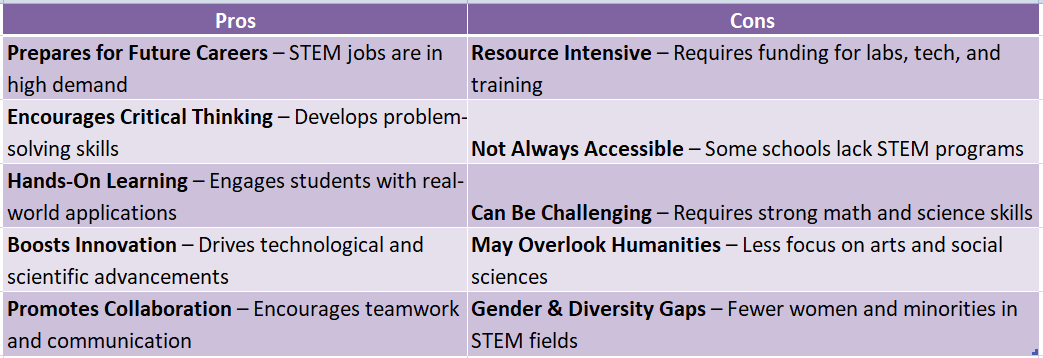
In today’s fast-paced world, Why STEM Education? is paramount. With technology advancing rapidly, the demand for skilled professionals in Science, Technology, Engineering, and Mathematics (STEM) is surging. This trend underscores the necessity of STEM education, which equips students with essential skills for a competitive job market.
Understanding the Shift in Job Markets
The job landscape is evolving, with many traditional roles being replaced by positions that require STEM skills. This shift highlights the need for educational systems to adapt and prepare students for future careers.
How Can Students Use AI in School
- Enhancing Learning: AI tools personalize education to fit individual learning styles.
- Streamlining Tasks: Automation of repetitive tasks allows students to focus on critical thinking and creativity.
- Preparing for the Future: Familiarity with AI technologies positions students for success in STEM fields.
Trends in Education
- Increased Focus on STEM: Schools are integrating STEM curricula to align with industry demands.
- Collaborative Learning: Group projects in STEM promote teamwork and problem-solving skills.
- Real-World Applications: Hands-on experiences in STEM education make learning relevant and engaging.
Unlock your potential with online degrees—Learn more!
How STEM Education Fosters Critical Thinking and Problem-Solving Skills

In today’s fast-paced world, the importance of STEM education is paramount. As we confront complex global challenges, equipping students with critical thinking and problem-solving skills becomes essential. STEM education excels in fostering a mindset that prepares students for future demands.
Encouraging Analytical Thinking
STEM education promotes the analysis of data, pattern recognition, and conclusion drawing, which are vital for understanding real-world issues. This analytical focus is a cornerstone of effective education.
Hands-On Learning Experiences
Through engaging projects and experiments, students apply theoretical knowledge in practical ways. This hands-on approach enhances their creativity and effectiveness in tackling challenges.
Collaboration and Communication
STEM education emphasizes teamwork, helping students learn to collaborate and communicate their ideas effectively. These skills are increasingly important in careers today, especially as trends in education highlight group work.
Additionally, by integrating technology like AI into their studies, students can enhance their learning. How can students use AI in school? They can leverage AI tools for research, simulations, and personalized learning, further honing their critical thinking and problem-solving abilities.
The Role of STEM in Driving Innovation and Economic Growth
In today’s rapidly evolving world, the significance of STEM education cannot be overstated. Why is STEM education more important than ever? It plays a crucial role in preparing students for a future where technology and innovation drive economic growth. As industries increasingly rely on science, technology, engineering, and mathematics, equipping students with these skills is essential for their success.
Fostering Critical Thinking
STEM education encourages students to think critically and solve complex problems. This mindset is vital as they navigate challenges in various fields, from healthcare to environmental science.
Preparing for Future Careers
- Diverse Opportunities: Careers in STEM fields are projected to grow significantly.
- AI Integration: How can students use AI in school? By incorporating AI tools, students can enhance their learning experience and prepare for tech-driven jobs.
Adapting to Trends in Education
STEM education is evolving with trends in education that emphasize hands-on learning and real-world applications. This approach not only makes learning engaging but also ensures students are ready to meet the demands of the modern workforce.
Why STEM Education is Essential for Future Job Markets
In today’s rapidly evolving world, understanding the significance of STEM education is crucial. As technology continues to advance, the demand for skilled professionals in science, technology, engineering, and mathematics is skyrocketing. This shift highlights why STEM education is essential for future job markets, preparing students for careers that are not only in high demand but also critical for innovation and economic growth.
The Role of AI in Education
- Enhancing Learning: How can students use AI in school? AI tools can personalize learning experiences, making complex subjects more accessible and engaging.
- Skill Development: Students can develop essential skills like coding and data analysis, which are increasingly sought after in various industries.
Trends in Education
- Integration of Technology: Schools are increasingly incorporating technology into their curricula, emphasizing the importance of STEM.
- Collaboration and Problem-Solving: Modern education trends focus on collaborative projects that mirror real-world challenges, preparing students for teamwork in their future careers.
How STEM Education Promotes Diversity and Inclusion in the Workforce
STEM education is more important than ever as it equips students with critical skills needed in a rapidly evolving job market. By fostering innovation and problem-solving abilities, it prepares learners for careers that are increasingly reliant on technology and scientific understanding. This is particularly crucial in a world where trends in education are shifting towards more integrated and interdisciplinary approaches.
Bridging the Gender Gap
- Encourages female participation in fields traditionally dominated by men.
- Provides mentorship programs to support young women in STEM.
Embracing Cultural Diversity
- Incorporates diverse perspectives in problem-solving.
- Promotes collaboration among students from different backgrounds, enhancing creativity and innovation.
STEM education not only prepares students for future careers but also emphasizes the importance of diversity and inclusion. By creating an environment where all voices are heard, we can ensure that future innovations reflect a wide range of experiences and ideas. This is vital as we explore how can students use AI in school to enhance learning and collaboration, ultimately leading to a more inclusive workforce.
What Are the Real-World Applications of STEM Learning?
In today’s fast-paced world, understanding the importance of STEM education is essential. Why STEM Education? It provides students with vital skills relevant across various industries. As technology evolves, the need for professionals in science, technology, engineering, and mathematics grows, making STEM education increasingly important.
STEM learning has practical applications that students can use daily. Here are key areas for applying STEM knowledge:
Everyday Problem Solving
- Critical Thinking: Students learn to analyze problems and create effective solutions.
- Innovation: STEM fosters creativity, leading to new inventions and enhancements in technology.
Career Opportunities
- Diverse Fields: STEM opens doors to careers in healthcare, engineering, and more.
- Job Security: STEM careers tend to be stable and lucrative due to high demand.
How Can Students Use AI in School?
- Personalized Learning: AI tailors educational experiences to individual needs.
- Enhanced Research: Students can use AI tools for efficient data analysis and projects.
As education trends shift towards technology integration, the significance of STEM education becomes clearer, preparing students for a tech-driven future.
Unlock your potential with online degrees—Learn more!
Why STEM Education is Key to Addressing Global Challenges
In today’s rapidly evolving world, the significance of STEM education cannot be overstated. As we face unprecedented global challenges—from climate change to technological disruptions—equipping students with skills in Science, Technology, Engineering, and Mathematics is essential. Why STEM Education? It fosters critical thinking, creativity, and problem-solving abilities that are crucial for addressing these complex issues.
The Role of AI in Education
STEM education also embraces innovative tools like artificial intelligence. How can students use AI in school? By integrating AI into their learning processes, students can enhance their research capabilities, personalize their learning experiences, and develop skills that are increasingly relevant in the job market. This not only prepares them for future careers but also empowers them to contribute solutions to global challenges.
Trends in Education
Moreover, current trends in education highlight the growing emphasis on interdisciplinary learning. Schools are increasingly blending STEM with arts and humanities, creating a holistic approach that encourages collaboration and innovation. This trend not only enriches the educational experience but also prepares students to think critically about the interconnectedness of global issues.
How Can CollegeAndTuition.com Support Your STEM Education Journey?
In today’s rapidly evolving world, the significance of STEM education has reached new heights. As technology advances and industries transform, understanding science, technology, engineering, and mathematics is crucial for students. This knowledge not only prepares them for future careers but also equips them with problem-solving skills essential for navigating life’s challenges.
Personalized Learning Resources
At CollegeAndTuition.com, we offer tailored resources that cater to individual learning styles. Whether you’re a visual learner or prefer hands-on activities, our platform provides diverse materials to enhance your understanding of STEM subjects.
Integration of AI in Learning
How can students use AI in school? By leveraging AI tools, students can access personalized tutoring, automate repetitive tasks, and engage in interactive learning experiences. This integration not only boosts comprehension but also keeps students motivated and engaged in their studies.
Staying Ahead of Trends in Education
With the ever-changing landscape of education, staying informed about trends is vital. CollegeAndTuition.com keeps you updated on the latest developments in STEM education, ensuring you have access to innovative teaching methods and resources that align with current industry demands.
The Future of STEM: Preparing Students for Tomorrow’s Opportunities
In today’s fast-paced world, the significance of STEM education is paramount. As technology advances, understanding science, technology, engineering, and mathematics becomes essential for students. Why STEM Education? It equips learners with vital skills for a competitive job market and nurtures critical thinking and problem-solving abilities necessary for innovation.
Embracing Technology in Learning
With the rise of artificial intelligence, students can utilize AI tools to enhance their learning. How Can Students Use AI in School? AI offers personalized tutoring and automates repetitive tasks, allowing students to concentrate on complex concepts and boost their academic performance. This technological integration not only makes learning engaging but also prepares students for future careers involving AI.
Trends in Education
Looking ahead, several educational trends emphasize STEM’s growing importance:
- Project-based learning that fosters collaboration and real-world problem-solving.
- Interdisciplinary approaches merging STEM with arts and humanities.
- Increased access to coding and robotics in the curriculum.
By adopting these trends, educators can effectively prepare students for future opportunities, equipping them to navigate an increasingly complex world.
Unlock your potential with online degrees—Learn more!
FAQs
-
What is STEM education?
STEM stands for Science, Technology, Engineering, and Mathematics. It focuses on hands-on, problem-solving, and critical thinking skills. -
Why is STEM education important?
STEM helps children develop analytical thinking, creativity, and problem-solving abilities, which are essential for future careers and everyday life. -
At what age should STEM education start?
STEM concepts can be introduced as early as preschool through play, exploration, and simple experiments. -
Is STEM only for kids interested in science and math?
No! STEM fosters skills like creativity, teamwork, and critical thinking, which benefit all children, regardless of their interests.





